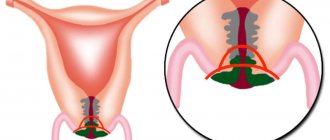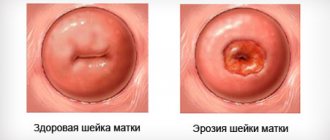Mechanism of action
The acids contained in solkovagin slightly cauterize the epithelium in the affected area of the cervix. It shrinks and dies. After a few days, it begins to be replaced by normal vaginal epithelium, which is where it should normally be.
If a drop of solution falls on the vaginal epithelium, only its surface cells are damaged. But this epithelium is multilayered, and in general nothing will happen to it if a drop of solution hits it. That is, after proper treatment there are no deep burns from it!
Analogs
— solcoderm (more about solcoderm). But solcoderm has a harsher effect. Thanks to this, the cervix is treated with solkovagin, and only the external skin is treated with solcoderm.
- condylin. Read the instructions for the condiline.
— duofilm. Only leather can be treated. Instructions for the duofilm.
- collomak. You can also treat only the skin. Read about Collomak.
Special instructions for the use of the drug Solkovagin
Treatment with the drug can only be carried out by a gynecologist; a cytological examination should be performed before use. In case of severe inflammation - preliminary sanitation. Treatment with Solkovagin is carried out on an outpatient basis and does not provide for any restrictions in taking water procedures or in sexual activity. The patient should be warned about the possibility of scanty discharge. Avoid contact of the drug with clothing, eyes, skin; if contact occurs, rinse immediately with water or 1% sodium bicarbonate solution.
Indications for use
- Ectopia of the cervical epithelium (ectropion, pseudo-erosion, in the old way - erosion of the cervix). Read a detailed article about erosion and ectopia of the cervix.
- Cervical polyp (if there is no endometrial pathology)
- Postoperative growths on the cervix (granulomas)
Is it possible to use Solkovagin for condylomas?
Yes, you can. A number of gynecologists treat condylomas in the vagina with a solution of solkovagin. But the mild effect of this drug does not give a pronounced effect for large condylomas. Therefore, the result will be insufficient.
If condylomas are 1-2 mm in size, then the use of solkovagin is possible and effective. Read all the information about genital warts.
To remove larger condylomas in the vagina, there are much more effective methods - laser, radio wave (Surgitron device), and the drug Solcoderm.
SOLCOVAGIN is a gentle alternative method for treating cervical pathology
Cervical pathology occupies a major place in the structure of gynecological diseases. Despite the variety of etiological factors, according to their clinical significance, cervical diseases are divided into background, precancerous and malignant. Conservative and surgical methods are used to treat them. In turn, conservative methods are divided into medicinal, non-medicinal (physiotherapeutic) and non-traditional. All these methods are used as independent treatment (monotherapy) or in combination with other types of therapy. They differ in the duration of use and low therapeutic effectiveness. Surgical treatment involves local or radical surgery. The surgical treatment method is highly effective, but is usually traumatic and often requires expensive equipment. The development of a large number of complications and prolonged healing of postoperative wounds significantly reduce the positive results of using this method. For example, the widely used diathermosurgical treatment method sometimes leads to the development of bleeding, stenosis or stricture of the cervical canal, cervical dystocia during childbirth, and endometriosis.
Among the pathological conditions of the cervix, the most common are background diseases. Although the risk of their malignant degeneration is low, due to their prevalence they are of significant scientific and practical interest. Such conditions are mainly diagnosed in nulliparous and young women, when gross interventions on the cervix are extremely undesirable. In such situations, conservative treatment methods are preferable. In this regard, the drug for the treatment of cervical pathology SOLCOVAGIN, produced in Switzerland, is of great scientific and practical interest.
Anatoly Boroda told the correspondent of the Weekly PHARMACY about the experience of using SOLCOVAGIN
Anatoly BEARD
Candidate of Medical Sciences, gynecologist at Clinical Hospital No. 18 in Kyiv
— For 4 years, at Clinical Hospital No. 18 in Kyiv, this drug has been successfully used to treat underlying diseases of the cervix. Its effectiveness was 95.6%, with no side effects noted.
— How does SOLCOVAGIN differ from other medications used to treat cervical diseases?
— The composition and nature of the therapeutic effect of the drug differs significantly from currently existing drugs. SOLCOVAGIN is an original combination of organic acids and zinc with nitric acid in optimal proportions, which has a cauterizing effect. The mechanism of action of SOLCOVAGINA is due to the morphofunctional difference between ectopic columnar and stratified squamous epithelium. The columnar epithelium of the cervix is much more susceptible to the fixing effect of SOLKOVAGIN than the stratified squamous epithelium. This makes it possible to achieve a selective devitalizing effect on altered cervical tissues without damaging healthy ones. In this case, the depth of the fixing effect of the drug on tissue reaches 2.5 mm, which is sufficient to destroy pathologically changed areas, but does not lead to gross damage to the underlying tissue. SOLCOVAGIN is intended for topical use only.
— What are the indications and regimen for using SOLCOVAGIN?
— Indications for treatment with SOLCOVAGIN are the following pathological conditions:
- ectopia of the columnar epithelium of the vaginal part of the cervix;
- completed (ovula Nabothi) and unfinished zone of benign transformation;
- glandular polyps of the cervix;
- postoperative granulomas.
The method of treatment with SOLCOVAGIN is extremely simple, it does not require expensive equipment or special training for the woman; therapy with the drug can be carried out in a regular gynecological office on an outpatient basis. Treatment with SOLKOVAGIN is absolutely painless, so anesthesia is not required.
The course of treatment consists of two applications of SOLCOVAGINA. The woman undergoes a generally accepted examination in such cases, including an analysis of discharge, a cytological examination of scrapings from the cervical canal and cervix, colposcopy, bimanual examination, and a blood test for the presence of syphilis (Wassermann reaction).
The cervix is exposed with speculum. Discharge from the mucous membrane of the cervix is removed with a cotton swab. To better visualize the boundaries of the lesion, the cervix is treated with a small amount of 3% acetic acid solution. Using a cotton swab on a wooden stick, soaked in SOLCOVAGIN solution, treat the affected area twice with an interval of 1–2 minutes. After each treatment, the tampon is changed.
The local action of SOLCOVAGIN causes devitalization of the columnar epithelium within a few minutes. This produces a yellowish-white or grayish scab - the result of chemical coagulation. The drug has no effect on healthy squamous epithelium of the vaginal walls and vaginal part of the cervix. The devitalized tissue remains on the surface of the cervix, forming a protective layer. After 3–5 days, the scab is painlessly and bloodlessly torn away, leaving a delicate epithelial surface. After treatment, scanty mucous discharge may appear, the presence of which is due to the rejection of the scab and epithelization. The healing process lasts 3–4 weeks. In most cases, one course of treatment is sufficient.
— Is there a need for a second course of treatment?
— Sometimes, with extensive and deep erosions of the cervix, when SOLCOVAGIN does not penetrate deep enough into the affected area, repeated courses of treatment are necessary. A follow-up examination, which is carried out after 4–6 days, allows a preliminary assessment of the effectiveness of treatment; in the presence of remaining areas of ectopia, a second course of therapy using the above method is recommended. If, after the fourth course of treatment with SOLCOVAGIN, partial or incomplete epithelization is observed, alternative treatment methods should be used.
The final follow-up examination is carried out 4 weeks after completion of the last course of treatment.
The use of SOLCOVAGINA is contraindicated in the presence of cellular dysplasia, suspected malignant process of the cervix, or inflammation.
The drug does not have a resorptive and therefore systemic effect.
— Is treatment with SOLCOVAGIN accompanied by painful sensations and is it necessary to limit sexual intercourse after using the drug?
— During treatment with SOLCOVAGIN, patients do not experience discomfort. Immediately after treatment, the patient can be sent home without any special restrictions regarding water procedures and sexual activity.
The results of the use of SOLCOVAGINA in Clinical Hospital No. 18 in Kiev indicate its high therapeutic effectiveness, ease of use, accessibility, absence of systemic and local negative effects, which is especially important for nulliparous women, when the use of other treatment methods can lead to the development of complications during childbirth .
Sob. cor. "PHARMACY Weekly"
Representative office in Ukraine, tel., 241-97-39
Instructions
1) The doctor wipes the surface of the cervix with a cotton swab, removing mucus.
2) In case of ectopia (erosion) of the cervix, the doctor first treats its surface with 3% acetic acid.
3) Pause 2-3 minutes. During this time, the surface of the ectopia becomes clearer against the background of the surrounding mucosa.
4) The doctor takes a wooden stick, wraps a cotton swab around it, dips it in the saline solution and treats the area of erosion (or ectopia) of the cervix.
5) Pause 3 minutes. During this time, the treated surface should change its color from pink to grayish-yellow-white.
6) The doctor re-treats the erosion with Solkovagin solution.
7) 10 days after treatment - examination by a gynecologist and monitoring of the condition.
 Another 14 days later - a second examination by a gynecologist.
Another 14 days later - a second examination by a gynecologist.
9) After another 14 days - a third examination by a gynecologist. If the pathology persists, the doctor treats it again.
Photos - before and after processing
Side effects and consequences
In case of an overdose of the drug, burns of the mucous membrane and scars occur.
If the procedure is performed correctly, there are no consequences after treatment!
Contraindications
- Cervical dysplasia
- Cervical cancer
- Pregnancy
Feedback from patients: burning and irritation in the first hours after treatment with the drug.
Is it possible to be sexually active after cauterization?
No, you cannot until the first examination by a gynecologist (10 days). After the examination, the gynecologist will look and tell you whether you can have sex or not. You can take a bath after 2 days. But better - a shower.
Use of the drug Solkovagin
No special preparation of the patient is required. Mucous discharge from the cervix is removed with a cotton swab. To more clearly define the boundaries, the cervix can be treated with 3% acetic acid solution. The affected area is treated with a cotton swab wound on a wooden stick and soaked in Solkovagin solution, twice with an interval of 1–2 minutes. In most cases, a single use of Solcovagin is sufficient. For extensive and deep erosion, in some cases it is recommended to re-treat after 4-6 days. If, during a follow-up examination after 4 weeks, it is determined that the erosion has not healed completely, a second course of treatment should be carried out (2 applications).










